
Image is from the University of Florida.
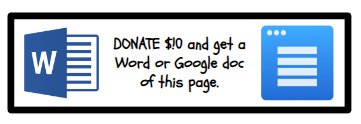

Multi-Tier System of Support (MTSS)
I took the MTSS and UDL Modules through University of Florida.
The following is taken from the University of Florida’s MTSS and UDL Module courses, verbatim in some cases. Information taken from the Massachusetts Department of Education is specified.
A prevention framework that organizes building-level resources to address each individual student’s academic and/or behavioral needs within intervention tiers that vary in intensity. MTSS allows for the early identification of learning and behavioral challenges and timely intervention for students who are at risk for poor learning outcomes. The increasingly intense tiers (i.e., Tier 1, Tier 2, Tier 3), sometimes referred to as levels of prevention (i.e., primary, secondary, intensive prevention levels), represent a continuum of supports.
- MTSS is data-based decision-making ~ collecting data, monitoring each student’s performance, and designing and implementing strategies and levels of support necessary so each learner can succeed.
- It is a fluid system that supports change as needed. MTSS provides a new way of addressing the needs of students who struggle and require intervention, despite the presence or absence of a disability.
- MTSS is a prevention framework that organizes building-level resources to address each student’s academic and behavioral needs.
- MTSS allows for the early identification of learning and behavioral challenges and provides timely intervention for students at risk for poor learning outcomes.
MTSS Components
- High-quality, differentiated, standards-based classroom instruction for all students. Teachers are highly qualified teachers who use evidence-based strategies, such as Universal Design for Learning.
- Systemic and sustainable change. Continuous improvement processes exist for grade or course-level, school site, and district teams.
- Integrated data system. School and district staff collaborate to create an Integrated data collection system that includes state tests, universal screening, diagnoses, progress monitoring data, teacher observations, and parent surveys. At my school, we do beginning, middle, and end of year DIBELS 8 testing for grades K-5, and we progress monitor the students at risk.
- Positive behavioral support. School site and district staff collaboratively select and implement school-wide, classroom, and research-based positive behavioral supports for achieving important social and learning outcomes. Our school assigns a teacher mentor to students at risk. The teacher meets with the child daily, 1:1, providing encouragement, support, and a special activity as needed as incentives.
- With MTSS, teams work together rather than in isolation.
- MTSS requires teams of general education teachers, education specialist teachers, parents, administrators, service providers at the local school and district levels, community organizations, and professional development trainers to work together for every student.
- MTSS shows promise in addressing the needs of all students and personalizing learning.
- As a school, the staff shares ownership for ALL students.
- General education teachers must be prepared to implement high-quality core content instruction that is evidence-based and differentiated to meet the needs of all learners. Special education teachers, instructional coaches, and teachers providing English language support must be prepared to assist with designing this core instruction and provide intensive intervention instruction using evidence-based practice and data to inform instructional decisions in concert with the general education teachers. At my school, we recognize that at-risk students need “double-dosing” of intensive instruction. Even though they may work with the reading specialist, they also work in a small groups with the classroom teacher.
MTSS
- A multi-tier approach is used to differentiate instruction for all students efficiently. The model incorporates increasing intensities of instruction, offering specific, research-based interventions matched to student needs.
- Universal screening is to develop entry and exit criteria for intervention tiers.
- Progress monitoring is a scientifically based practice used to assess students’ academic performance, evaluate the effectiveness of instruction, and assist teachers in making instructional decisions for individual students or an entire class.
Principles of MTSS
- Intervening early
- Data-based decision making
- Integration and sustainability
- Use of evidence-based practices
Critical Features of the MTSS Framework
- Universal screening
- Data-based decision-making and problem-solving
- Continuous progress monitoring
- Focus on successful student outcomes
- Continuum of evidence-based interventions
- A core curriculum is provided for all students
- A modification of this core is arranged for students who are identified as non-responsive
- A specialized and intensive curriculum for students with intensive needs
- Focus on successful student outcomes
Benefits of MTSS
MTSS eliminates the “wait to fail” situation. MTSS supports teachers with instructionally relevant, easily understood information, which allows teachers to know what works now to improve students’ skills. And MTSS encourages better collaboration between teachers and families. (The staff at my school holds “meet and greets,” and free book drives at the housing projects that our school serves. Many parents do not own vehicles, so the teachers go to them.) Additionally:
- Provides specific types of support for teachers in the form of professional development, technical assistance, and instructional coaching;
- Outlines clearly defined roles, responsibilities, and accountability for teachers, building leaders, and district personnel;
- Provides a coherent system for continuous improvement;
- Ensures that a common understanding or language exists when discussing implementation and expected outcomes;
- Benefits ALL students when the model is implemented with fidelity!
What My School is Doing for Families
- Teachers hold periodic “Meet and Greet” at the housing projects, give away books, teach parents how to get a library card, and discuss community resources.
- “Blessings in a Backpack” ~ students who need food over the weekend are slipped food into their backpacks in their lockers.
- We have a room of gently used clothing and coats for students in need.
- We have translators and remote conferences for those who need them.
- We have complimentary breakfast and free lunch for every student.
- Students with social-emotional issues are assigned a teacher mentor who spends 1:1 time with the student daily.
- Families in need around the holidays can contact the school for assistance.
- We follow up with families of students with frequent absences.
- The Student-Teacher Assistance Team meets to discuss strategies if we have a student of concern.
- We have a full-time school adjustment counselor who can meet with students and talk to families.
Meeting Students’ Behavioral Needs
- MTSS includes Response to Intervention (RTI) and Positive Behavioral Intervention and Supports (PBIS) frameworks.
- Every student receives core instruction, known as Tier One. Some students need supplemental instruction, Tier Two, and a small cohort of students receive the most intensive intervention and support, known as Tier Three. This tiered system is used for academic and behavioral support.
- Addressing students’ social and emotional needs allows all students the opportunity to thrive and succeed in school.
- If a student is misbehaving, a need isn’t getting met.
- Students are typically in Tier Two for at least four-and-a-half weeks and in Tier Three from nine to 27 weeks, with progress monitored regularly.
- My elementary school started a mentor program. Students with social/emotional challenges are assigned a staff member who checks in with them daily and makes them feel safe, secure, and optimistic about school.
Best Practices for Behavioral Needs
- Teach and review positive behavior expectations frequently.
- Teach and review classroom routines and cues.
- Implement informal and formal systems of positive reinforcement.
- Active supervision in all settings.
- Continuum of appropriate consequences enforced consistently and fairly.
- Provide opportunities to respond to instruction to increase comprehension, allow reluctant learners a secure environment to practice, and decrease disruptions.
Tier 1
- Core instruction for the whole class in a regular classroom. All students receive practical, differentiated instruction by a classroom teacher using an evidence-based core curriculum and positive behavior management strategies.
- During Tier 1 instruction, the teacher identifies students who may need additional support using key indicators (poor grades, absenteeism, signs of abuse/neglect, behavioral problems, and other signs of disengagement).
- Students with these at-risk factors who are not responding to usual support are referred to the MTSS team. The team meets and discusses the students who need additional support and lays out a student plan. Tier 1 is expected to bring approximately 80% of students to acceptable proficiency levels.
- Tier 1 behavior is typically taught at Morning Meetings. Behavioral expectations are taught, and common language is shared. Some schools use the Second Step program or Open Circle. We use Calm Classroom.
Tier 2
- Short-term support for those students identified during Tier 1.
- Tier 2 supplements core instruction using targeted, evidence-based small-group interventions to help them catch up.
- Students may also get classroom push-in support from the school counselor.
- This supplemental instruction is expected to bring up to 15% of students to proficient levels. This may involve additional tutoring, one-on-one counseling, a behavior contract, or a self-monitoring plan.
- Parents are included in the discussions; progress monitoring is critical.
- Students who respond well to Tier 2 additional supports are returned to Tier 1, and students with slow progress remain in Tier 2, while students who do not respond to the other supports are reviewed for Tier 3.
Tier 3
- Intensive, evidence-based interventions are designed to increase the rate of student progress for the approximately 5% of students who need very intensive 1:1 intervention.
- Good progress after these supports results in the student being returned to Tier 1 or Tier 2. Slow progress results in the student continuing in Tier 3. No or minimal progress results in the student’s eligibility for referral for special education evaluation, which means parental consent, more intensive evaluations, and IEP.
- When personal safety, family crisis or death, abuse, trauma, and suicidal/homicidal ideation are present, students at any level will be immediately placed in Tier 3.
RECAP
MTSS is NOT RtI. MTSS is an umbrella term that includes RtI and PBIS. It is an integrated system that provides for academic and behavioral considerations. According to the University of Florida MTSS Module, here is how MTSS is different than RtI:
- MTSS encompasses RtI and more!
- MTSS addresses the academic, social, emotional, and behavioral development of children from PreK-12.
- MTSS provides multiple levels of support for all learners (struggling through advanced).
- MTSS aligns resources and support for students receiving instruction AND for teachers and other support staff delivering the instruction.
- MTSS endorses Universal Design for Learning (UDL) instructional strategies so all students have opportunities for learning through differentiated content, processes, and product.
- MTSS framework is an educational system change paradigm continuously focused on overall school improvement that is sustainable.
- MTSS models ensure that practices, policies, and programs are aligned at the classroom, school, and district levels.
- MTSS benefits from continued support for teachers in delivering instruction, utilizing and developing effective curriculum, administering assessments, and using data to guide instruction.
- MTSS requires greater collaboration between general education and special education within each school and between the school and the district office.
- MTSS also includes a focus on intervention but has a more vital goal of prevention than perhaps RtI does.
- MTSS is more likely to produce professional development across school and district settings.
- MTSS requires teachers, administrators, district personnel, and student support specialists to change how they have worked together to include a more collaborative and cohesive culture.
This is how one school implemented and communicated MTSS: MTSS-St-Johns-School0001.
Here is a PERFECT example of MTSS taken from the University of Florida MTSS Module:
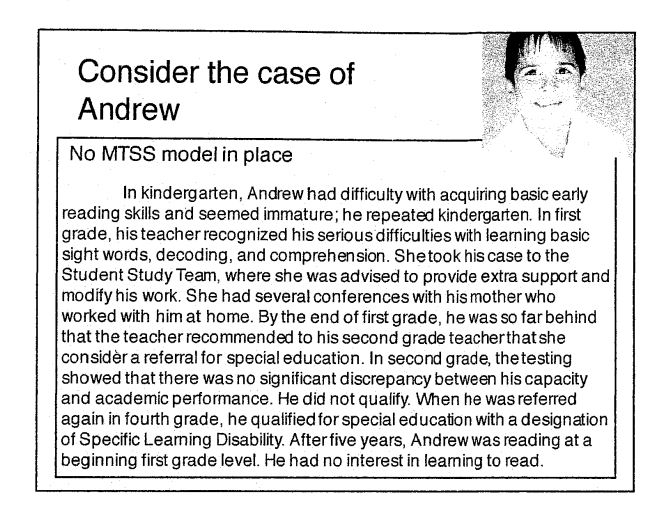
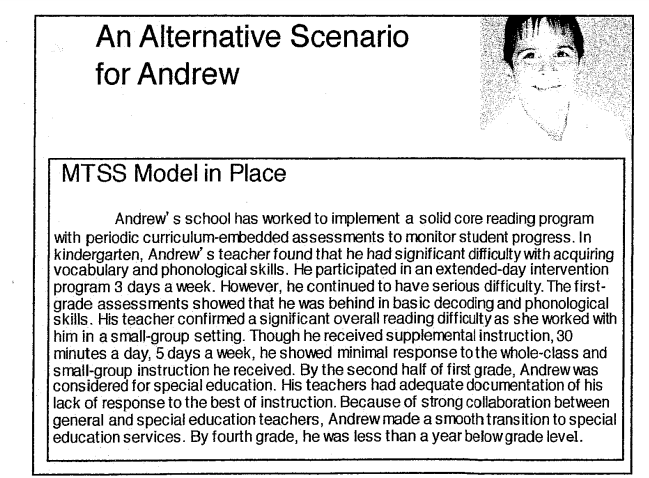
According to TNTP Reimagining Teaching, there are 3 priorities:
1. Welcome Students and Families to the Classroom: Students feel welcome. Teachers continually seek student and family feedback and foster a strong partnership with each family. Examples:
- Engage students in activities to promote relationship building.
- Support the development of social and emotional competencies.
- Have a parent communication plan.
2. Establish Systems to Monitor Student Understanding: Collect timely and relevant data. Analyze data to plan for instruction. Examples:
- Establish alternative ways for demonstrating comprehension for beginning ELs.
- Collaborate with special ed teachers, ESL teachers, and instructional specialists.
3. Review and Adjust Curriculum and Pacing: Use high-quality grade-appropriate curricula and materials. Provide differentiated and “just-in-time” interventions to address gaps. Examples:
- Anticipate and plan for potential barriers.
- Maintain rigorous expectations for all.
Universal Design for Learning (UDL)
UDL is a set of principles for curriculum development that give all individuals equal opportunities to learn. UDL is a framework for guiding educational practice that provides flexibility in student engagement, information presentation, and avenues for students to respond or demonstrate knowledge and skills.
Inclusive Classrooms | Mrs. Judy Araujo, M.Ed., CAGS (mrsjudyaraujo.com)
UDL At A Glance
- The way each person learns is at unique as their fingerprints.
- We ALL have diverse learners.
- “Universal” means we all have something to offer ~ backgrounds, strengths, needs, and interests.
- Our brain has 3 broad networks. Learning involves recognition (what), skills (how), and caring (why).
- Students need knowledge, skills, and enthusiasm!
- “Design” ~ wheelchair ramps are for wheelchairs and helpful for strollers and bikes. Closed captioning is for deaf people, but it is also beneficial to people working out in gyms, people learning English, and children learning to read.
- UDL is goals, methods, materials, and assessments for EVERYONE!
ASK:
- What are my goals?
- What are the barriers?
- Provide multiple means of representation to teach the material.
- Provide multiple means of action and expression so students can demonstrate what they know.
- Provide multiple means of engagement.
UDL-lesson-plan-template.pdf (epsd.us).
Mass Literacy – Massachusetts Department of Elementary and Secondary Education
The following charts came from foundational skills (1)

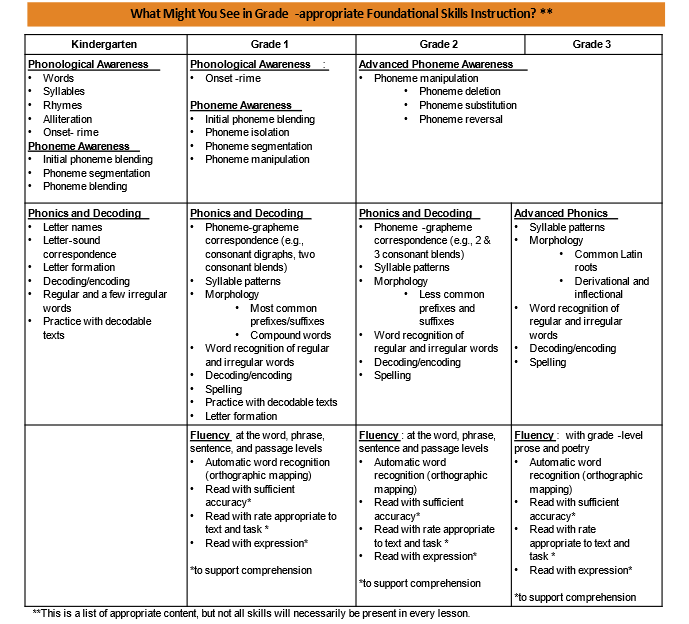
Standards of Effective Practice During Foundational Skills Instruction
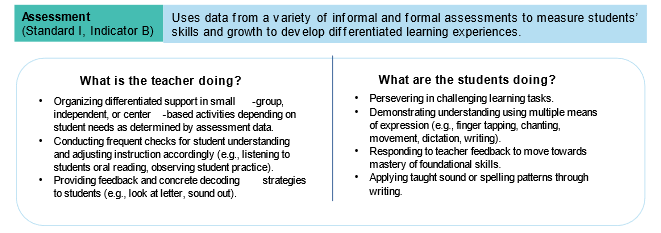
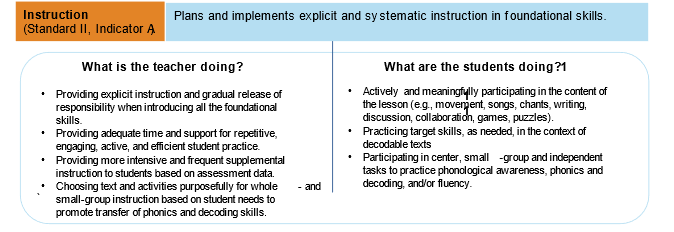
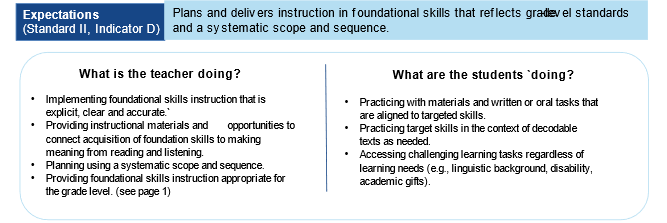
CUrriculum RAtings by TEachers (CURATE) – Center for Instructional Support (mass.edu)
Components of the Core Literacy Block – Evidence-Based Early Literacy (mass.edu)
English Language Arts and Literacy (mass.edu)
The following graphics came from Assisting Students Struggling with Reading: Response to Intervention (RtI) and Multi-Tier Intervention in the Primary Grades (ed.gov).
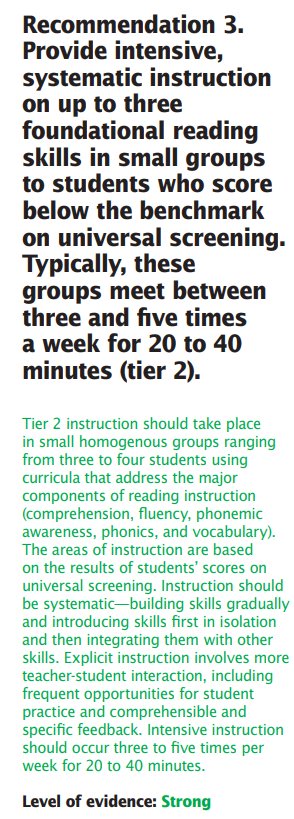
This recommendation is the only recommendation in the guide with STRONG evidence.
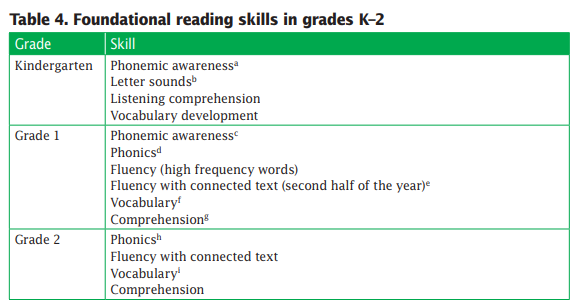

edited on 03/08/2024
![]()

